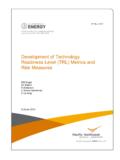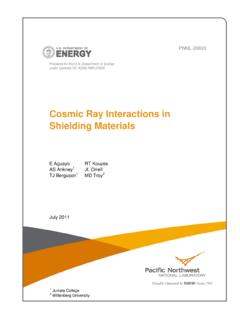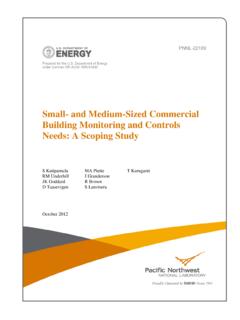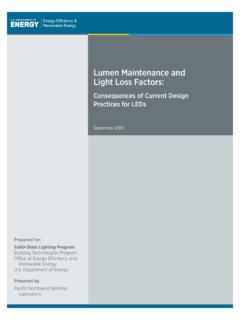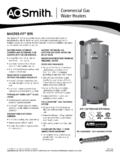Transcription of ANSI/ASHRAE/IES Standard 90.1-2013 Determination of …
1 PNNL-23481 Prepared for the Department of Energy under Contract DE-AC05-76RL01830 ANSI/ASHRAE/IES Standard Determination of Energy Savings: Qualitative Analysis M Halverson M Rosenberg R Hart E Richman R Athalye D Winiarski August 2014 PNNL-23481 ANSI/ASHRAE/IES Standard Determination of Energy Savings: Qualitative Analysis M Halverson M Rosenberg R Hart E Richman R Athalye D Winiarski August 2014 Prepared for the Department of Energy under Contract DE-AC05-76RL01830 Pacific Northwest National Laboratory Richland, Washington 99352 iii Executive Summary Section 304(b) of the Energy Conservation and Production Act (ECPA), as amended, requires the Secretary of Energy to make a Determination each time a revised version of ashrae Standard is published with respect to whether the revised Standard would improve energy efficiency in commercial buildings. When the Department of Energy (DOE) issues an affirmative Determination on Standard , states are statutorily required to certify within two years that they have reviewed and updated the commercial provisions of their building energy code, with respect to energy efficiency, to meet or exceed the revised Standard .
2 To meet these statutory requirements, the DOE Building Energy Codes Program (BECP) and Pacific Northwest National Laboratory (PNNL) conduct two types of analysis in a Determination of energy savings for a revised Standard : Qualitative Analysis: This is a detailed textual analysis that identifies all the changes made to the previous edition of Standard and categorizes the changes as having a positive, negative, or neutral impact on energy efficiency in commercial buildings. In the qualitative analysis, no attempt is made to estimate a numerical impact using whole building simulation. Three steps are typically undertaken in the qualitative analysis: identify all changes made to Standard , characterize the impact of each change on the energy efficiency of Standard , and identify those changes that can be incorporated into the subsequent quantitative analysis. Quantitative Analysis: This analysis uses the results of the qualitative analysis to identify which changes should be incorporated into the building simulation models to estimate the energy impact resulting from the changes to Standard This report provides the qualitative analysis of all addenda to ansi / ashrae /IES1 Standard (referred to as Standard or 2010 edition) that were included in ANSI/ASHRAE/IES Standard (referred to as Standard or 2013 edition).
3 All addenda in creating Standard were evaluated for their projected impact on energy efficiency. Each addendum was characterized as having a positive, neutral, or negative impact on overall building energy efficiency. The textual analysis indicated that 52 of a total of 110 changes have positive impact on energy efficiency, including 8 changes evaluated as having a major positive impact and 44 changes with a minor positive impact on energy efficiency. Of the remaining changes, 53 were neutral (had neither a positive or negative impact on energy efficiency). These include editorial changes, changes to reference standards , changes to alternative compliance paths, and other changes to the text of the Standard that may improve the usability of the Standard , but do not generally affect the energy efficiency of a building. Five changes were identified as having a minor negative impact on energy efficiency. The eight addenda that have major positive impacts on energy efficiency are as follows: 1.
4 Addendum adds control requirements for lighting alterations. 2. Addendum applies new efficiency requirements to individual fans. 1 American National standards Institute/American Society of Heating, Refrigerating, and Air Conditioning Engineers/Illuminating Engineering Society of North America iv 3. Addendum reduces energy usage for large boilers. 4. Addendum reduces fan energy usage and improves economizer effectiveness. 5. Addendum increases stringency of building envelope requirements. 6. Addendum adds new efficiency requirements for commercial refrigeration. 7. Addendum requires more lighting controls in more spaces and reduces time to reduction or shutoff. 8. Addendum decreases lighting power density in most building types. The five addenda that have negative impacts on energy efficiency are as follows: 1. Addendum reduces energy efficiency ratio for evaporatively cooled air conditioners.
5 2. Addendum relaxes air leakage requirements for high-speed doors. 3. Addendum relaxes the U -factor requirement for residential steel joist floors in Climate Zone 3. 4. Addendum relaxes economizer requirements for computer rooms. 5. Addendum eliminates sizing requirements for pipes above 24" in diameter. Addenda characterized as resulting in negative energy saving impacts are judged to be relatively minor, indicting no significant energy impact. The 44 addenda that are rated as minor positives are discussed in Section 4. A comparison of the number of major positives and minor positives (a total of 52 positives) to the number of minor negatives (5) indicates that the overall impact on the Standard is positive. v Acronyms and Abbreviations AHRI Air Conditioning, Heating, and Refrigeration Institute AHU air handling unit AMCA Air Movement and Control Association ansi American National standards Institute ashrae American Society of Heating, Refrigerating and Air-Conditioning Engineers ASME American Society of Mechanical Engineers ATC acceptance test code BECP Building Energy Codes Program bhp brake horsepower BOD Board of Directors Btu British thermal unit(s) Btu/h British thermal unit(s) per hour cfm cubic feet per minute CFR Code of Federal Regulations COP coefficient of performance CRRC Cool Roof Rating Council CSA Canadian standards Association CTI Cooling Tower Institute DDC direct digital control(s)
6 DOE Department of Energy DX direct expansion ECB energy cost budget ECPA Energy Conservation and Production Act EER energy efficiency r atio EPAct 2005 Energy Policy Act of 2005 EPCA Energy Policy and Conservation Act FC filled cavity FEG fan efficiency grade gpm gallon(s) per minute HERS home energy rating systems hp horsepower HSPF heating season performance factor HVAC heating, ventilation, and air-conditioning HVACR heating, ventilation, air-conditioning, and refrigeration IEC International Electrotechnical Commission IEER Integrated Energy Efficiency Ratio IES Illuminating Engineering Society of North America IESNA Illuminating Engineering Society of North America IPLV integrated partial load value LPD lighting power density vi LSG light-to-solar-gain ratio NAECA National Appliance Energy Conservation Act NEMA National Electrical Manufacturers Association NFPA National Fire Protection Association NFRC National Fenestration Rating Council NR not required PNNL Pacific Northwest National Laboratory OA outdoor air PTAC packaged terminal air conditioner PTHP packaged terminal heat pump PUE power utilization effectiveness RH relative humidity SDHV small duct high velocity SEER seasonal energy efficiency ratio SHGC solar heat gain coefficient SPVAC single package vertical air conditioner SPVHP single package vertical heat pump SWH service water heating VAV variable air volume
7 VRF variable refrigerant flow VSD variable speed drive VT visible transmittance WWR window-to-wall ratio water column vii Contents Executive Summary .. iii Acronyms and Abbreviations .. v Introduction .. Addenda Included in Standard .. Impacts of Addenda in Standard .. Detailed Discussion of Impacts of Addenda on Various Sections of Standard .. Changes to Title, Section 1 Purpose, and Section 2 Scope Changes to Section 3, Definitions, Abbreviations, and Acronyms Changes to Section 4, Administration and Enforcement Changes to Section 5, Building Envelope and Normative Appendices A D Changes to Section 6, Heating, Ventilating, and Air-Conditioning Changes to Section 7, Service Water Heating Changes to Section 8, Power Changes to Section 9, Lighting Changes to Section 10, Other Equipment Changes to Section 11, Energy Cost Budget Method Changes to Section 12, Normative References Changes to Informative Appendix E, Informative References Changes to Informative Appendix F Addenda Description Information Changes to Normative Appendix G, Performance Rating Method References.
8 Appendix A . Comparison of Building Envelope Requirements in Standard and Standard .. Tables Table Complete List of Addenda Processed for ashrae Standard .. Table Impact Assessment of Addenda for ashrae Standard .. Table Summary of Addenda Impact .. Table Results of Textual Analysis by Section of Standard Table Water to Air Heat Pump Efficiency Improvements .. Table Addendum 2010 Boiler Turndown Requirements .. Table Addendum Fan Speed Control and Staging Requirements .. Table Addendum 2010 Energy Recovery Requirements .. Table Restructuring of Section 9 in .. Table Addendum 2010 Space-by-Space Lighting Power Changes .. viii Table Addendum 2010 Building Area Lighting Power Changes .. Table Addendum Building Area Method Light Power Changes .. Table Addendum Space-by-Space Light Power Changes .. Table Addendum Lighting Power Changes .. Figures Figure Technical Section Addenda Count by Energy Efficiency Impact.
9 Introduction Title III of the Energy Conservation and Production Act, as amended (ECPA), establishes requirements for the Building Energy Efficiency standards Program (42 6831 et seq.). Section 304(b), as amended, of ECPA provides that whenever the ansi / ashrae /IESNA1 ( Standard or 1989 edition), or any successor to that code, is revised, the Secretary must make a Determination , not later than 12 months after such revision, whether the revised code would improve energy efficiency in commercial buildings and must publish notice of such Determination in the Federal Register (42 6833 (b)(2)(A)). The Secretary may determine that the revision of Standard , or any successor thereof, improves the level of energy efficiency in commercial buildings. If so, then not later than 2 years after the date of the publication of such affirmative Determination , each State is required to certify that it has reviewed and updated the provisions of its commercial building code regarding energy efficiency with respect to the revised or successor code (42 6833(b)(2)(B)(i)).
10 The State must include in its certification a demonstration that the provisions of its commercial building code, regarding energy efficiency, meet or exceed the revised Standard (42 6833(b)(2)(B)(i)). If the Secretary makes a Determination that the revised Standard will not improve energy efficiency in commercial buildings, State commercial codes shall meet or exceed the last revised Standard for which the Secretary has made a positive Determination (42 6833(b)(2)(B)(ii)). ECPA also requires the Secretary to permit extensions of the deadlines for the State certification if a State can demonstrate that it has made a good faith effort to comply with the requirements of Section 304(c) of ECPA and that it has made significant progress in doing so (42 6833(c)). On October 9, 2011, DOE issued an affirmative Determination of energy savings for Standard , which concluded that Standard would achieve greater energy efficiency in buildings subject to the code, than Standard (76 FR 64904).
